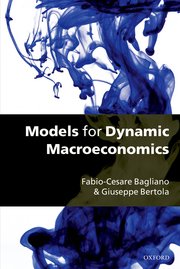
Oxford University Press, 2007, pp. 275, ISBN: 978-0-19-922832-4
|
Oxford University Press book site
|
Description
This is a textbook for advanced students in macroeconomics. It
provides
the advanced student with key methodological tools for the dynamic
analysis
of a selection of core macroeconomic phenomena, including
consumption and
investment choices, employment and unemployment
outcomes, and economic
growth. The technical treatment of these tools will enable the
student
to handle current journal literature, while not assuming any
particular
familiarity with advanced analytical tools or mathematical
notions. As
these tools are introduced, they are related to particular
applications
to illustrate their use.
Contents
Chapters are linked by various formal and conceptual
threads. Discrete-time
optimization under uncertainty, introduced in Chapter
1, is motivated and discussed by applications to
consumption
theory. Chapter 2 deals with continuous-time
optimization techniques
in the context of partial-equilibrium investment models. Chapter
3
revisits many of the previous chapters' formal derivations with
applications
to dynamic labor demand, in analogy to optimal investment models,
and characterizes
labor market equilibrium when not only individual firms' labor
demand is
subject to adjustment costs, but also individual labor supply by
workers
faces dynamic adjustment issues. Chapter 4 proposes
broader applications
of methods introduced by the previous chapters, and studies
equilibrium
dynamics of a representative-agent economy featuring both
consumption and
investment choices, in continuous time. Chapter 5
characterizes
aggregate labor market dynamics in the presence of frictional
unemployment.
Chapters 4 and 5 pay particular attention to coordination
problems, a peculiarly
macroeconomic feature of real-life economies: even when each agent
correctly
solves his or her individual dynamic problem, strategic
interactions and
externalities play an essential role in many modern microfounded
macroeconomic
models. The text offers many exercises and outlines their
solution.
Readership and use
The treatment is technical, but it is motivated as a natural
sequel
to the intuitive arguments of standard undergraduate textbooks,
and does
not require analytical tools beyond those covered by an
introductory undergraduate
mathematics course. The material is suitable for advanced
undergraduate
and basic graduate macroeconomics courses of about sixty lecture
hours.
When complemented by recent journal articles, the individual
chapters can
also be used in specialized topics courses. The last section of
each chapter
often sketches more advanced material and may be omitted without
breaking
the book's train of thought, while the chapters' appendices
introduce technical
tools and are essential for typical readers. Some exercises are
found within
the chapters and propose extensions of the model discussed in the
text.
Other exercises are found at the ends of chapters and should be
used to
review the material.